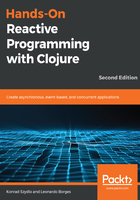
上QQ阅读APP看书,第一时间看更新
Arrowized FRP
This is the last formulation we will look at. Arrowized FRP[5] introduces two main differences over higher-order FRP: it uses signal functions instead of signals and is built on top of John Hughes' Arrow combinators[6].
It is mostly about a different way of structuring code and can be implemented as a library. As an example, Elm supports Arrowized FRP via its Automaton (see https://github.com/evancz/automaton) library.
The first draft of this chapter grouped the different formulations of FRP under the broad categories of Continuous and Discrete FRP. Thanks to Evan Czaplicki's excellent talk, Controlling Time and Space: understanding the many formulations of FRP (see https://www.youtube.com/watch?v=Agu6jipKfYw), I was able to borrow the more specific categories that are used here. These come in handy when discussing the different approaches to FRP.